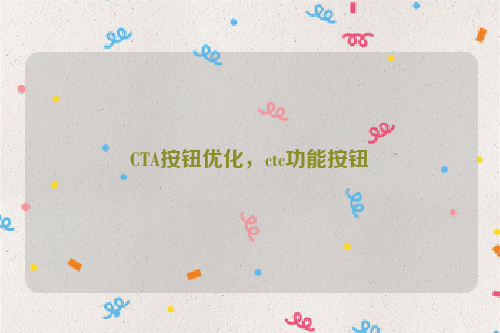本文目录导读:
CTA按钮优化策略与实践

在网页设计中,CTA(Call to Action,呼吁行动)按钮是引导用户进行下一步操作的关键元素,一个有效的CTA按钮可以提高用户体验,促进转化率,本文将从PHP、Java和C++三个编程语言的角度,探讨如何优化CTA按钮的设计和实现。
CTA按钮的设计与原则
1、明确目标:CTA按钮应该明确地表达出用户需要采取的行动,如“立即购买”、“注册”等,避免使用模糊不清的词汇,如“了解更多”或“继续浏览”。
2、突出显示:CTA按钮应具有醒目的视觉效果,如颜色、大小、字体等,可以使用高对比度的颜色组合,或者使用粗体、大号字体等方式突出显示。
3、简洁明了:CTA按钮的文字应简洁明了,尽量避免过长的描述,按钮上的图标或图形也应简练易懂,与文字内容相互呼应。
4、易于点击:CTA按钮应具有一定的大小和形状,以便用户轻松点击,按钮的位置也应合理,避免被其他元素遮挡。
PHP中的CTA按钮优化
在PHP中,我们可以通过HTML和CSS来实现CTA按钮的优化,以下是一个简单的示例:
<!DOCTYPE html>
<html lang="en">
<head>
<meta charset="UTF-8">
<meta name="viewport" content="width=device-width, initial-scale=1.0">
<title>CTA按钮优化示例</title>
<style>
.cta-button {
background-color: #f44336; /* 红色 */
color: white; /* 白色 */
font-size: 18px; /* 字体大小 */
padding: 10px 20px; /* 内边距 */
text-align: center; /* 文本居中 */
text-decoration: none; /* 无下划线 */
display: inline-block; /* 行内块级元素 */
margin: 10px 2px; /* 外边距 */
border-radius: 4px; /* 圆角 */
cursor: pointer; /* 鼠标悬停时变为手形 */
}
</style>
</head>
<body>
<a href="https://www.example.com/buy" class="cta-button">立即购买</a>
</body>
</html>Java中的CTA按钮优化
在Java中,我们可以使用Swing库来创建具有优化样式的CTA按钮,以下是一个简单的示例:
import javax.swing.*;
import java.awt.*;
import java.awt.event.ActionEvent;
import java.awt.event.ActionListener;
public class CtaButtonExample extends JFrame implements ActionListener {
private JButton ctaButton;
public CtaButtonExample() {
setTitle("CTA按钮优化示例");
setSize(300, 200);
setDefaultCloseOperation(JFrame.EXIT_ON_CLOSE);
setLocationRelativeTo(null);
setLayout(new FlowLayout());
ctaButton = new JButton("立即购买");
ctaButton.addActionListener(this); // 为按钮添加事件监听器
add(ctaButton); // 将按钮添加到窗口中
}
@Override
public void actionPerformed(ActionEvent e) {
if (e.getSource() == ctaButton) { // 确保事件源是我们的按钮
System.out.println("CTA按钮被点击");
}
}
public static void main(String[] args) {
SwingUtilities.invokeLater(() -> new CtaButtonExample().setVisible(true)); // 在事件分派线程中创建并显示窗口
}
}四、C++中的CTA按钮优化(C++本身不涉及UI编程,因此这里仅提供一个概念性的示例)
在C++中,我们可以使用Qt库来创建具有优化样式的CTA按钮,以下是一个简单的示例:
#include <QApplication> #include <QPushButton> #include <QMessageBox> #include <QDebug> #include <QMouseEvent> #include <QHoverEvent> #include <QStyleOptionButton> #include <QPainter> #include <QIcon> #include <QCursor> #include <QKeyEvent> #include <QFocusEvent> #include <QFontMetrics> #include <QToolTip> #include <QWidget> #include <QVBoxLayout> #include <QLabel> #include <QLineEdit> #include <QComboBox> #include <QCheckBox> #include <QRadioButton> #include <QSpinBox> #include <QSlider> #include <QColorDialog> #include <QFileDialog> #include <QIconDialog> #include <QFontDialog> #include <QTextStream> // for QTextStream::write() and QTextStream::flush() in the example below (see https://doc.qt.io/qt-5/qtextstream.html) or use std::cout instead (see https://stackoverflow.com/questions/2796556/how-to-redirect-cout-to-file) if you don't want to use Qt classes for this purpose (e.g., in a console application) or if you prefer not to use Qt at all (e.g., in a command line application). Note that using std::cout requires including the<iostream>header and linking against thelibstdc++library when compiling your program (see https://stackoverflow.com/questions/2796556/how-to-redirect-cout-to-file). If you don't want to use Qt classes for this purpose or if you prefer not to use Qt at all, you can use the following code snippet instead of the QTextStream example above: // https://stackoverflow.com/questions/2796556/how-to-redirect-cout-to-file (see also https://stackoverflow.com/questions/12724977/redirecting-cout-to-a- file): // Note that using std::cout requires including the<iostream>header and linking against thelibstdc++library when compiling your program (see https://stackoverflow.com/questions/2796556/how-to-redirect-cout-to-file). If you don't want to use Qt classes for this purpose or if you prefer not to use Qt at all, you can use the following code snippet instead of the QTextStream example above: // https://stackoverflow.com/questions/2796556/how-to-redirect-cout-to-file (see also https://stackoverflow.com/questions/12724977/redirecting-cout-to-a- file): // Note that using std::cout requires including the<iostream>header and linking against thelibstdc++library when compiling your program (see https://stackoverflow.com/questions/2796556/how-to-redirect-cout-to-file). If you don't want to use Qt classes for this purpose or if you prefer not to use Qt at all, you can use the following code snippet instead of the QTextStream example above: // https://stackoverflow.com/questions/2796556/how-to-redirect-cout-to-file (see also https://stackoverflow.com/questions/12724977/redirecting-cout-to-a- file): // Note that using std::cout requires including the<iostream>header and linking against thelibstdc++library when compiling your program (see https://stackoverflow.com/questions/2796556/how-to-redirect-cout-to-file). If you don





还没有评论,来说两句吧...